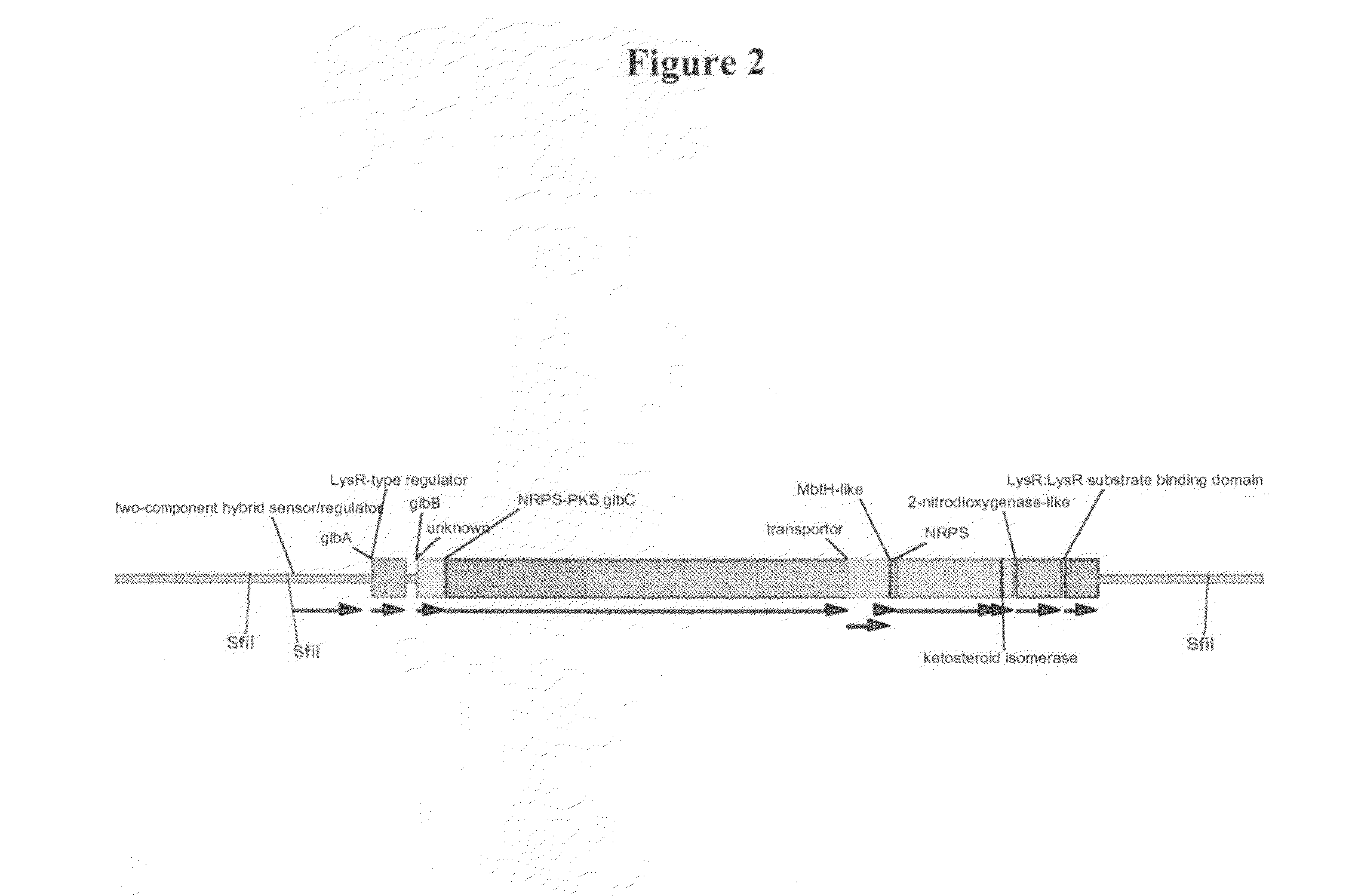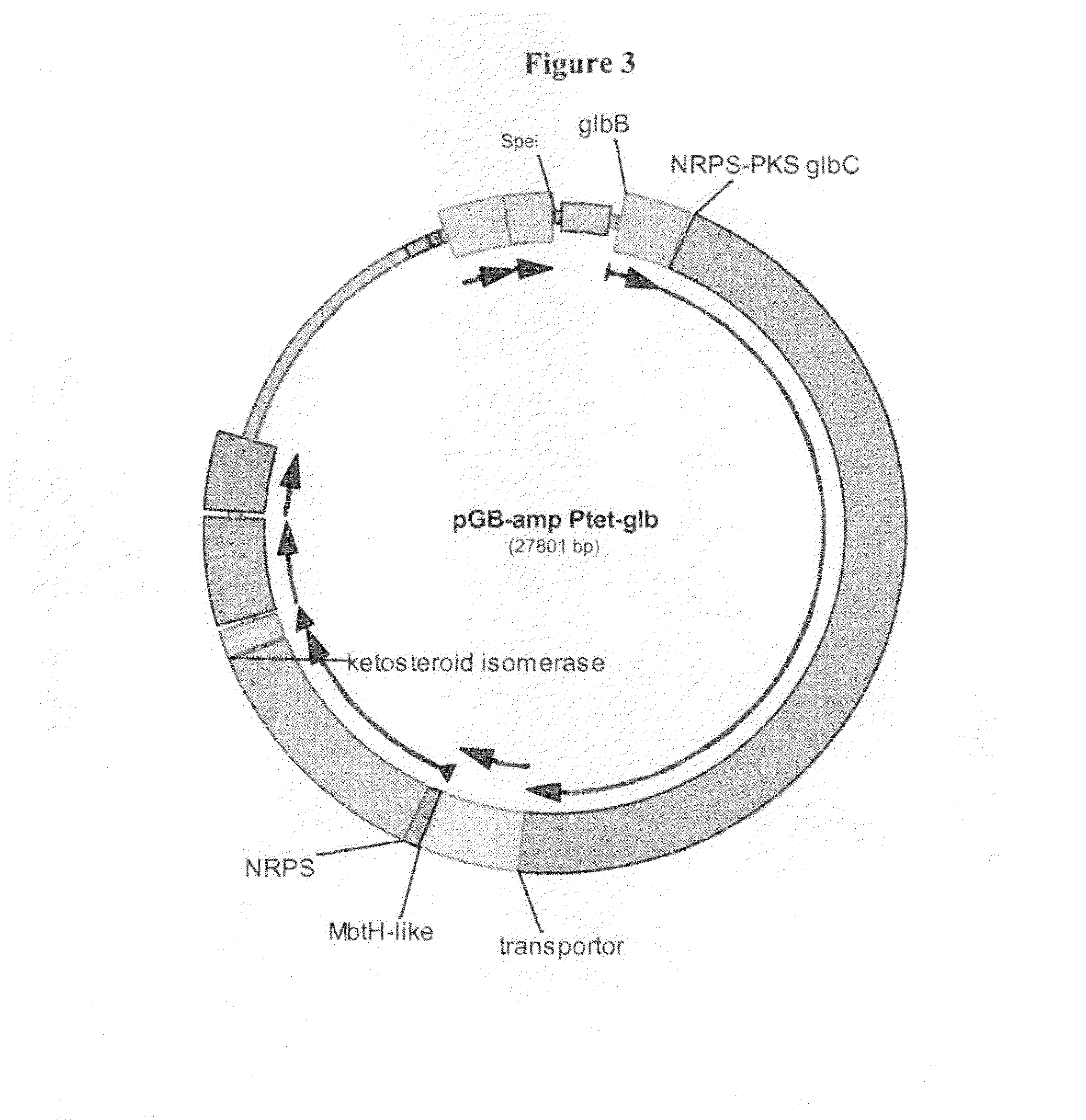Heterologous hosts
- Summary
- Abstract
- Description
- Claims
- Application Information
AI Technical Summary
Benefits of technology
Problems solved by technology
Method used
Image
Examples
example 1
The Generation of Expression Plasmids for the Expression of Glidobactin in DSM7029
[0103]To allow the expression of glidobactin A in heterologous hosts, RecET system was used to clone the glidobactin (glb) gene cluster.
[0104]To clone the glb gene cluster, genomic DNA from DSM7.029 was prepared and digested with Sfi I. YZ2005, comprising RecE and RecT, was then transformed with this genomic preparation and a linear vector to utilise RecET to subclone the gene cluster into a plasmid (FIG. 3).
[0105]The construct was further modified to allow the expression of the metabolites in DSM7029 Burkholderia. ColE1 plasmids cannot replicate in DSM7029 so the construct was integrated into the chromosome of DSM7029. The p15A origin of replication and a transposase cassette (Tpase-bsd-oriT) from p15A-Tn5-neo-epo-Tpase-BSD-oriT was used to replace the colE1 origin (FIGS. 4 and 5).
[0106]Glidobaction A, B and C were produced from the endogenous glb gene cluster It is therefore demonstrated that such ge...
example 2
Heterologous Expression of Epotholines in DSM7029
[0108]The epothilone gene cluster was engineered to carry the transposase (Tps) and invert sequences (IR) as described above. Using RecE, a 57-59 kb DNA fragment comprising the epothilone gene cluster under the Tn5 constitutive promoter was cloned and integrated into the chromosome of DSM 7029.
[0109]Transformation was performed according to the following protocol using ice-cold dH2O, and Eppendorfs and electroporation cuvettes cooled to 2° C.
1. A hole was made in the lid of a 1.5 ml Eppendorf tube and a single colony was inoculated in 1.0 ml of CY medium. The cells were cultured overnight at 37° C. with shaking at 900 rpm.
2. A hole was made in the lid of a 2.0 ml Eppendorf tube and 1.9 ml of CY medium was inoculated with 50 μl of the overnight culture.
3. The 2.0 ml tube was incubated at 37° C. with shaking at 1100 rpm for 5 hours.
4. The cells were centrifuged at 9000 rpm for 20 seconds at 2° C. The supernatant was discarded and placed...
example 3
Reclassification of DSM7029
[0114]DSM7029 was previously classified as a myxobacterium. However, myxobacteria are characterised by a long doubling time and slow growth. In contrast, DSM7029 grows fast and its doubling time was estimated as 1 hour. Therefore, it was investigated whether DSM7029 is, in fact, a myxobacterium. 16S rRNA coding sequences from DSM7029 strains (wild-type and kan1) were amplified and sequenced.
Partial sequence of 16S rRNA gene of DSM7029 wildtype(SEQ ID NO: 1)CCCTTATGACTACTTGTTACGACTTCACCCCAGTCACGAACCCTGCCGTGGTGATCGCCCTCCTTGCGGTTAGGCTAACCACTTCTGGCAGAACCCGCTCCCATGGTGTGACGGGCGGTGTGTACAAGACCCGGGAACGTATTCACCGCGGCATGCTGATCCGCGATTACTAGCGATTCCGACTTCACGCAGTCGAGTTGCAGACTGCGATCCGGACTACGACCGGTTTTCTGGGATTAGCTCCCCCTCGCGGGTTGGCAGCCCTCTGTACCGGCCATTGTATGACGTGTGTAGCCCTACCCATAAGGGCCATGATGACCTGACGTCATCCCCACCTTCCTCCGGTTTGTCACCGGCAGTCTCATTAGAGTGCCCTTTCGTAGCAACTAATGACAAGGGTTGCGCTCGTTGCGGGACTTAACCCAACATCTCACGACACGAGCTGACGACGGCCATGCAGCACCTGTGTCCAGGTTCTCTTTCGAGCACTCCCACATCTCTGCAGGATT...
PUM
| Property | Measurement | Unit |
|---|---|---|
| Time | aaaaa | aaaaa |
Abstract
Description
Claims
Application Information
 Login to View More
Login to View More - Generate Ideas
- Intellectual Property
- Life Sciences
- Materials
- Tech Scout
- Unparalleled Data Quality
- Higher Quality Content
- 60% Fewer Hallucinations
Browse by: Latest US Patents, China's latest patents, Technical Efficacy Thesaurus, Application Domain, Technology Topic, Popular Technical Reports.
© 2025 PatSnap. All rights reserved.Legal|Privacy policy|Modern Slavery Act Transparency Statement|Sitemap|About US| Contact US: help@patsnap.com



